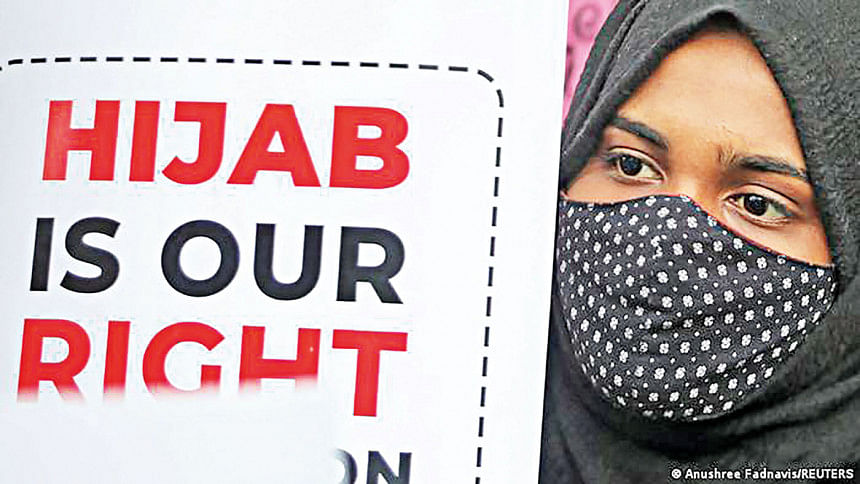Headscarves: Liberalism, secularism and human rights regime put to question

Human rights regime seems somewhat confused in balancing between liberal democratic values of freedom of religion and keeping educational institutions free from religious symbolism. Eurocentric interpretation of human rights favours banning headscarf for the sake of its secular identity at the cost of outright abandonment of religious freedom.
Headscarves are garments mostly worn by Muslim women across the world as per religious obligations. But many educational institutions do not allow headscarves in the campus. A number of countries have prohibited wearing headscarves in schools. Even where headscarf is not legally banned, intolerance towards this particular mode of dressing seems to have gradually increased. Justification for banning headscarves ranges from protecting the 'liberal' and 'secular' feature of the state to guaranteeing gender equality. Consequently, the question arises whether the principles of liberalism, secularism and human rights justify banning headscarves.
Freedom, rights and equality are the foundation of liberalism, and the idea of liberalism prohibits sanctioning any act unless it causes harm to others. It advocates for the highest possible personal autonomy. Wearing headscarf is simply a matter of personal choice regarding the way someone wants to dress up. In order to ban a particular mode of dressing, as per liberal view, a set of indisputable facts and rationale must be established that veiling causes harm to others. Mere worries and imaginary fear do not meet the requirement. Headscarf may offend those who do not like it but it is not 'offensive'. Difference between 'being offended' and 'offensive' can be better understood in terms of 'free speech', where one particular statement may offend many even though the statement does not amount to offence. Judge Tulkens, the lone dissenter, held a similar view in Shahin v Turkey.
The argument that Muslim women wearing the headscarf may compel others to do so is not satisfactory since there is no supporting evidence for such claim. One argument against headscarf is that wearing headscarf indicates that women are subjugated. If so, how can a subjugated person force values to another independent person? Contrarily, women who wear headscarves may face humiliation, abuse and discrimination for their choice of dressing. It begins as 'micro-aggression' and later on results in violent abuse and greater discrimination.
A liberal state is supposed to be neutral. The headscarf debate is as simple as that – a group is fighting for the right to wear it and another group is fighting for not to wear it. Both camps are exercising a harmless practice based on free choice. No liberal state can take a side in this debate. The state should maintain equidistance from both sides but ensure that no one can force their choice onto the unwilling. When a public authority bans headscarf, it suggests that the state wants a particular form of apparel to be worn. This attitude is destructive to the core values of liberalism.
Secularism means public affairs must be separated from religious dictation. Secularism has two dimensions: first, 'liberal secularism' which allows people to manifest her religious conviction in public sphere; and secondly, 'fundamentalist secularism' which prohibits religious expression in public and relegates religious freedom to the private domain. Fundamentalist secular view fails to appreciate the distinction between those who merely wear headscarf and those who forces it to others. When headscarf is banned for protecting secular environment, secular framework seems unable to accommodate the women who want to veil themselves out of free choice. Such stringent form of secularism undermines multiculturalism and promotes intolerance towards some particular cultural and religious values.
Human rights regime seems somewhat confused in balancing between liberal democratic values of freedom of religion and keeping educational institutions free from religious symbolism. Eurocentric interpretation of human rights favours banning headscarf for the sake of its secular identity at the cost of outright abandonment of religious freedom. A group of human right scholars argue that most women wear headscarf due to coercion and suggest banning it for ensuring liberation of women. But the truth is that educated, empowered women also wear headscarf out of free choice. Banning underestimates their autonomy and dignity. Thus, banning headscarf is equally paternalistic and coercive as much as compelling one to wear it.
Gender equality argument appears as a popular justification against the right to wear headscarf. Arguments for banning headscarf is mostly based on the stereotype that all Muslim women are oppressed, dominated and subjugated by their male family members and they are coerced into wearing the headscarf. Therefore, ban is necessary for emancipation of oppressed women. But do the women who veil themselves out of free will still need emancipation? Can the removal of certain garments play an emancipatory role? How does wearing headscarf infringe equality? If headscarf is held responsible for gender discrimination, a universal ban operating both in public and private sphere seems justified. Contrarily, ban on headscarf can be counterproductive. Where women are forced to cover themselves upon religious dictation, parents may allow them to go to school if schools allow her covering herself. But if the school forces her to unveil, parents may prevent them from getting education. Education and financial independence should be the top-priority for women liberation. Hence, can 'unveiling' be an essential prerequisite for getting education or ensuring equality?
The writer is an apprentice lawyer.

 For all latest news, follow The Daily Star's Google News channel.
For all latest news, follow The Daily Star's Google News channel. 



Comments